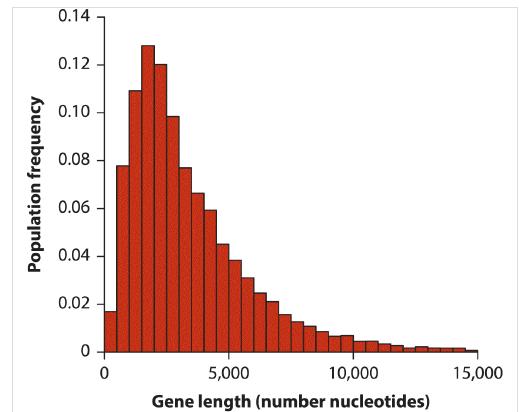Our unique random sample of 100 human genes from the human genome (Example 4.1) was found to
Question:
Our unique random sample of 100 human genes from the human genome (Example 4.1) was found to have a median length of 2640.5 nucleotides. Specify whether each of the following statements is true or false.
a. The median gene length of all human genes is 2640.5 nucleotides.
b. The median gene length of all human genes is estimated to be 2640.5 nucleotides.
c. The sample median has a sampling distribution with a standard error.
d. A random sample of 1000 genes would likely yield an estimate of the median closer to the population median than a random sample of 100 genes.
Data from Example 4.1
The international Human Genome Project was the largest coordinated research effort in the history of biology. It yielded the DNA sequence of all 23 human chromosomes, each consisting of millions of nucleotides chained end to end. These encode the genes whose products—RNA and proteins—shape the growth and development of each individual. We obtained the lengths of all 20,290 known and predicted genes of the published genome sequence (Hubbard et al. 2005). The length of a gene refers to the total number of nucleotides comprising the coding regions. The frequency distribution of gene lengths in the population of genes is shown in Figure 4.1-1. The figure includes only genes up to 15,000 nucleotides long; in addition, there are 26 longer genes. Distribution of gene lengths in the known human genome. The graph is truncated at 15,000 nucleotides: 26 larger genes.
Figure 4.1-1

The histogram in Figure 4.1-1 is like those we have seen before, except that it shows the distribution of lengths in the population of genes, not simply those in a sample of genes. Because it is the population distribution, the relative frequency of genes of a given length interval in Figure 4.1-1 represents the probability of obtaining a gene of that length when sampling a single gene at random. The probability distribution of gene lengths is positively skewed, having a long tail extending to the right. The population mean and standard deviation of gene length in the human genome are listed in Table 4.1-1. These quantities are referred to as parameters because they are quantities that describe the population.

In real life, we would not usually know the parameter values of the study population, but in this case we do. We’ll take advantage of this to illustrate the process of sampling.
Step by Step Answer:

The Analysis Of Biological Data
ISBN: 9781319226237
3rd Edition
Authors: Michael C. Whitlock, Dolph Schluter





